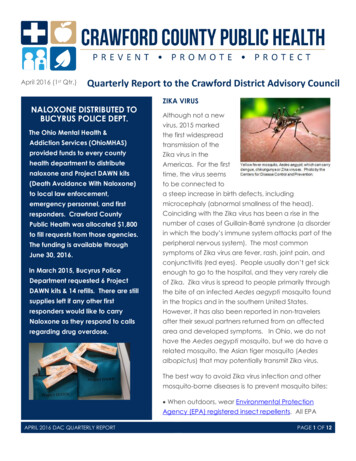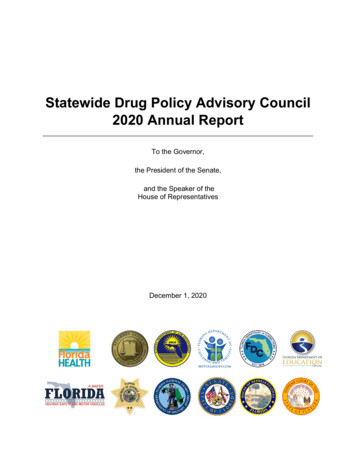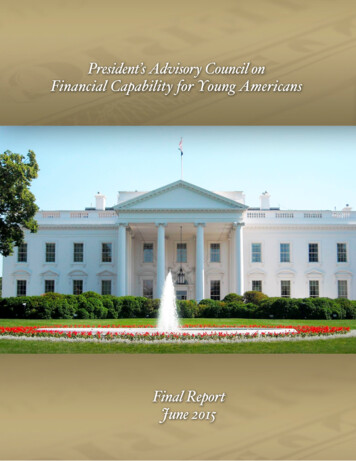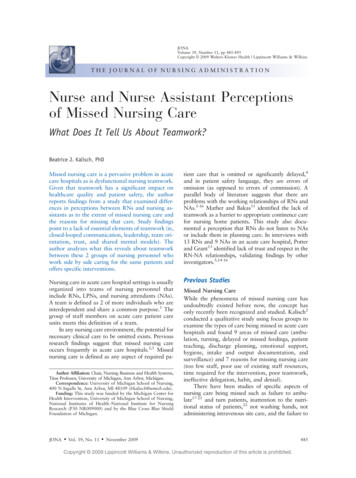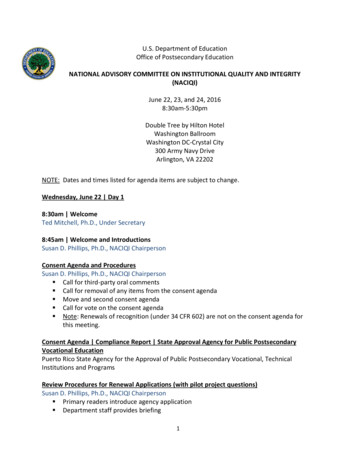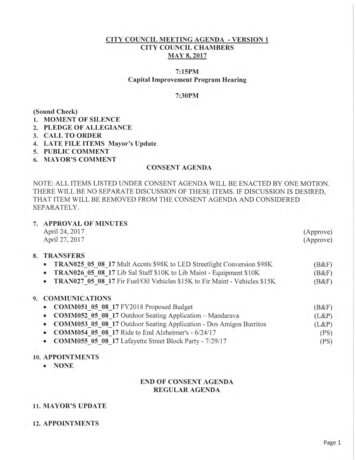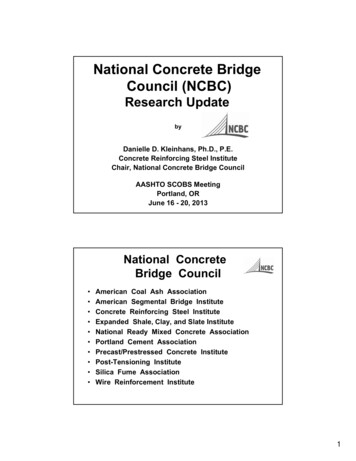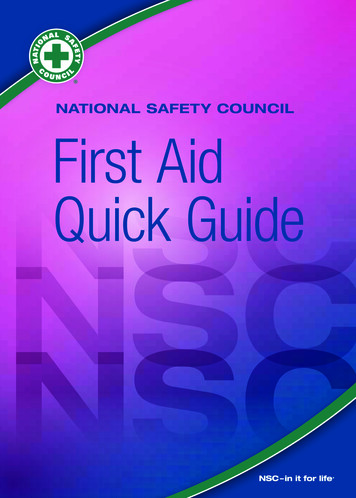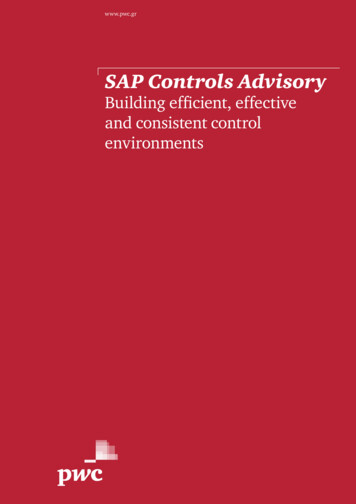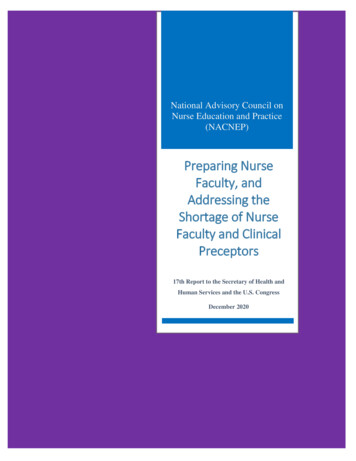
Transcription
National Advisory Council onNurse Education and Practice(NACNEP)Preparing NurseFaculty, andAddressing theShortage of NurseFaculty and ClinicalPreceptors17th Report to the Secretary of Health andHuman Services and the U.S. CongressDecember 2020
Preparing Nurse Faculty, and Addressing theShortage of Nurse Faculty and Clinical PreceptorsNational Advisory Council on Nurse Education and Practice17 Report to the Secretary of Health and Human Services and the U.S. CongressthDecember 2020The views expressed in this document are solely those of the National Advisory Council on Nurse Education andPractice and do not necessarily represent the views of the U.S. Government.
Table of ContentsThe National Advisory Council on Nurse Education and Practice 1NACNEP Membership for the 17th Report 2Acknowledgements 4Executive Summary 5Recommendations for the Secretary of HHS and Congress on the Nurse Faculty Shortage 6Introduction 8The National Nurse Faculty Shortage – Background 9Faculty Shortage Today 10Federal and Philanthropic Efforts to Address the Nurse Faculty Shortage 16State Board Requirements for Nursing Faculty and Preceptors 21Continuing Challenges 24Conclusion 24NACNEP Recommendations with Rationale on the Nurse Faculty Shortage 27References 29List of Abbreviations 33Appendix 1: National League for Nursing Core Competencies for Nurse Educators with Tasks 34Appendix 2: Comparative Demographics of Faculty and Student Enrollments, 2010-2019 38Appendix 3: Teacher Educator Technology Competencies 39
The National Advisory Council on Nurse Education and PracticeThe Secretary of Health and Human Services (HHS) and, by delegation, the Administrator of theHealth Resources and Services Administration (HRSA), are charged under Title VIII of thePublic Health Service Act, as amended, with responsibility for a wide range of activities insupport of nursing education and practice including: enhancement of the composition of thenursing workforce; improvement of the distribution and utilization of nurses to meet the healthneeds of the nation; expansion of the knowledge, skills, and capabilities of nurses to enhance thequality of nursing practice; development and dissemination of improved models of organization,financing, and delivery of nursing services; and promotion of interdisciplinary approaches to thedelivery of health services, particularly in the context of public health and primary care.AuthorityAuthority is granted though section 851 of the Public Health Service Act, as amended (42 U.S.C.297t). The Council is governed by provisions of the Federal Advisory Committee Act, asamended (5 U.S.C. Appendix 1-16), which sets forth standards for the formation and use ofadvisory committees.FunctionThe National Advisory Council on Nurse Education and Practice (NACNEP, or the Council)advises and makes recommendations to the Secretary and Congress on policy matters arising inthe administration of Title VIII, including the range of issues relating to the nurse workforce,nursing education, and nursing practice improvement. The Council may make specificrecommendations to the Secretary and Congress regarding programs administered by theDivision of Nursing and Public Health, particularly within the context of the enabling legislationand the Division’s mission and strategic directions, as a means of enhancing the health of thepublic through the development of the nurse workforce.Additionally, the Council provides advice to the Secretary and Congress in preparation ofgeneral regulations and with respect to policy matters arising in the administration of this titleincluding the range of issues relating to nurse supply, education, and practice improvement.1 P ageNACNEP 17th Report: Faculty Shortage
NACNEP Membership for the 17th ReportMarsha Howell Adams, PhD, RN, CNE,ANEF, FAANDean and ProfessorCollege of NursingUniversity of Alabama in HuntsvilleHuntsville, AlabamaMaryann Alexander, PhD, RN, FAANChief Officer, Nursing RegulationNational Council of State Boards of NursingEditor-in-Chief, Journal of NursingRegulationChicago, IllinoisCynthia Bienemy, PhD, RNDirectorLouisiana Center for NursingLouisiana State Board of NursingBaton Rouge, LouisianaMary Ellen Biggerstaff, DNP, MSN, FNPFamily Nurse PractitionerSummit Pacific Medical CenterElma, WashingtonSteven Brockman-Weber, DNP, RN, MS,FACHE, NEA-BC, CENPChief Nursing OfficerAscension TexasAustin, TexasMary Brucker, PhD, CNM, FACNM,FAANAssistant ProfessorSchool of NursingGeorgetown UniversityEditor, Nursing for Women’s HealthArlington, Texas2 P ageAnn Cary, PhD, MPH, RN, FNAP, FAANProfessorCollege of Health and Human ServicesFlorida Gulf Coast UniversityEstero, FLTammi Damas, PhD, MBA, WHNP-BC,RNAssociate DeanCollege of Nursing and Allied HealthSciencesHoward UniversityWashington, District of ColumbiaChristine DeWitt, RN, BSN, PCCNStaff Registered NurseCardio-Thoracic Surgery Step DownOhio State Wexner Medical CenterRoss Heart HospitalColumbus, OhioRose Kearney-Nunnery, PhD, RNUniversity of South Carolina BeaufortProfessor/Chair RetiredBluffton, South CarolinaMaryjoan Ladden, PhD, RN, FAANConsultantRobert Wood Johnson FoundationPrinceton, New JerseyLorina Marshall-Blake, FAAN, MGAPresidentIndependence Blue Cross FoundationPhiladelphia, PennsylvaniaDonna Meyer, MSN, RN, ANEF, FAADNChief Executive OfficerOrganization for Associate Degree NursingSan Diego, CaliforniaNACNEP 17th Report: Faculty Shortage
Luzviminda Miguel, DNP, MSN Ed., RNAssistant Professor/Nursing ProgramCoordinator/Nursing FacultyThe University of Hawai’i at Hawai’iCommunity CollegeVolcano, Hawai’iPatricia Marie Selig, RN, PhD, APRN,FNP-BCDirector, Center for Advanced PracticeVirginia Commonwealth University HealthSystemRichmond, VirginiaJanice Phillips, PhD, RN, CENP, FAANDirector of Nursing Research and HealthEquityNursing AdministrationRush University Medical CenterAssociate ProfessorRush University College of NursingChicago, IllinoisLaDonna Selvidge, MSN, MEd, RNDirector of Practical NursingFrancis Tuttle Technology CenterOklahoma City, OklahomaCol. Bruce Schoneboom, PhD, MHS,CRNA, FAANAssociate Dean for Practice, Innovation andLeadershipJohns Hopkins School of NursingBaltimore, MarylandRoy Simpson, DNP, RN, DPNAP, FAAN,FACMIAssistant Dean, Technology ManagementProfessorNell Hodgson Woodruff School of NursingAtlanta, GeorgiaFederal StaffChairCAPT Sophia Russell, DM, MBA, RN,NE-BCDirectorDivision of Nursing & Public HealthBureau of Health WorkforceHealth Resources and ServicesAdministrationRockville, MarylandTechnical WriterRaymond J. Bingham, RN, MSNTechnical Writer and EditorDivision of Nursing and Public HealthBureau of Health WorkforceHealth Resources and ServicesAdministrationRockville, MarylandDesignated Federal OfficerCamillus Ezeike, PhD, JD, LLM, RN,CHC, CPHRMSenior AdvisorDivision of Nursing and Public HealthBureau of Health WorkforceHealth Resources and ServicesAdministrationRockville, Maryland3 P ageNACNEP 17th Report: Faculty Shortage
AcknowledgmentsNACNEP’s 17th Report was developed as collaborative effort involving all Council members.While all members contributed to the report, the following two subcommittees – the writing andplanning subcommittees – were indispensable in the development of the report:Writing CommitteeDr. Ann Cary, Team LeadDr. Janice PhillipsDr. Maryjoan LaddenDr. Lorina Marshall-BlakeDr. Mary Ellen BiggerstaffDr. Patricia SeligPlanning CommitteeDr. Tammi DamasDr. Marsha Howell-AdamsDr. Steven Brockman-WeberDr. Maryjoan LaddenDr. Lorina Marshall-BlakeAdditionally, the Council would like to recognize the efforts of the following federal staff fromthe Health Resources and Services Administration, Bureau of Health Workforce, Division ofNursing and Public Health: NACNEP Chair CAPT Sophia Russell, NACNEP DesignatedFederal Official Dr. Camillus Ezeike, LT CMDR Leslie Poudrier, and Mr. Raymond J. Bingham.NACNEP appreciates the hard work and dedication of all these individuals in producing thisreport.4 P ageNACNEP 17th Report: Faculty Shortage
Executive SummaryAmerica is in the midst of a crisis threatening the supply, education, and training of registerednurses (RNs) – a severe and long-standing shortage of nurse faculty and clinical preceptors.Efforts to increase the supply of nurse faculty have largely failed, while the number of clinicalpreceptors to supervise nursing students in patient care is inadequate to meet the current need. Inthe preparation of students to enter the nursing profession and oversee the health, well-being, andsafety of patients under their care, both teaching roles are crucial.At around 4 million strong, nursing is the largest of the health professions. America needsnurses, as RNs play critical roles across the health care system, and serve as first responders andcrucial providers in emergent conditions such as the current COVID-19 pandemic. Nursessupport and promote the health, function, and wellness of society. Nursing is consistently rankedas the most trusted profession, and nurses represent the face of the healthcare system.The National Advisory Council on Nursing Education and Practice (NACNEP) has previouslyaddressed the nurse faculty shortage. Its ninth report, published in 2010, identified several keyfactors affecting the supply of nurse faculty, including non-competitive salaries, high workloads,poor understanding and respect for the faculty role, and a lack of diversity in the nurse facultyworkforce. The report’s recommendations spurred millions of dollars of investments from theHealth Resources and Services Administration and other federal agencies, along with stategovernments and philanthropic organizations. However, the faculty shortage continues.The 2010 report and recommendations were a necessary response, and they retain the support ofthe current NACNEP members. However, the past ten years have demonstrated these steps wereinsufficient to set a course correction to increase and improve the nurse faculty workforce, andthey failed to address the shortage of clinical preceptors.Recent surveys and workforce studies have shown on ongoing high rate of nurse facultyvacancies at schools of nursing. More ominously, they also point to an impending increase infaculty retirements, creating a significant “brain drain” that will exacerbate the current facultyshortage. Studies have also shown that a lack of full-time faculty has an adverse impact on thequality of nursing education.Most faculty positions at schools of nursing require or prefer applicants with a doctoral degree innursing, either the research-based PhD, or the practice-based Doctor of Nursing Practice (DNP).PhD-prepared nurses are the predominant human capital required for nursing faculty, however,both PhD and DNP programs often lack essential coursework in the science of nursingeducation, educational pedagogy, learning theory, or student assessment. Furthermore, thecompetencies needed for nurse faculty are in flux, as more education is shifting to distancelearning or other on-line formats, and sites of care are changing.The clinical training of nursing students requires the availability of a clinical preceptor. Mostpreceptors are not faculty members, but rather are practicing RNs who provide a one-on-onerelationship to help the student develop clinical skills and competencies, and acclimate to the5 P ageNACNEP 17th Report: Faculty Shortage
role of a professional RN. Preceptors would benefit from increased training to integrate theirclinical and teaching roles.HRSA has developed several programs that aim to increase the number and improve the trainingof nurse faculty and preceptors. In addition, a number of philanthropic organizations haveinvested in programs to improve nursing scholarship and increase the number of faculty. Still,these efforts have proven inadequate.Another challenge is different guidelines and requirements among different state nursing boardsfor faculty and preceptors, which may complicate recruitment efforts and inhibit the mobility ofnurse faculty. The COVID-19 pandemic has significantly limited the clinical learningopportunities of nursing students nationwide and thus has implications for ensuring an adequatesupply of faculty and preceptors to prepare the next generation of nurses.NACNEP believes that federal efforts alone will not be able to solve the looming crisis of thenurse faculty shortage and improve the development and training of both faculty and preceptors.There is a need to explore new programs and begin a coordinated public-private response todevelop, support, and fund a wide range of initiatives to improve the status and nurse faculty andenhance nursing education and training.Recommendations for the Secretary of HHS and Congress on theNurse Faculty Shortage1. The U.S. Congress, through the Department of Health and Human Services and the Department ofEducation, should allocate specific funding to programs that promote an increase in the number ofnurse faculty and clinical preceptors, and that support nurse faculty development by incorporatingacademic coursework in nursing education theory and pedagogy within graduate nursing curricula toprepare nurses to assume teaching positions as either faculty or preceptors upon completion.2. The U.S. Congress should provide funding for the Health Resources and ServicesAdministration to develop a nurse faculty residency program that emphasizes strategies toimprove faculty recruitment, preparation, development, and retention.3. The U.S. Congress should allocate specific funding for the creation of a national centerdevoted to nursing education and the development of nurse faculty and clinical preceptors.NACNEP further recommends that the Health Resources and Services Administration leadthe implementation of this center as a federal-private partnership, in coordination withprofessional nursing and non-federal philanthropic organizations. NACNEP envisions thatthis center would advance nursing education by: Developing, supporting, and disseminating best practices in the academic preparationand continuing education needs of qualified nurse educators, nurse faculty, andclinical preceptors; Engaging in data collection on nurse faculty, and housing a national repository ofinformation on nurse faculty employment, distribution, and retention;6 P ageNACNEP 17th Report: Faculty Shortage
Piloting innovative projects to support the development and promote the recruitmentand retention a diverse nurse faculty and preceptor workforce; Working to improve the image of the nurse faculty role, and raising the visibility ofand respect for the nurse faculty role as a rewarding career choice; Encouraging and coordinating the development of academic-practice partnerships tosupport nurse faculty employment and advancement; Promoting greater uniformity among state boards of nursing and credentialing bodiesin nursing faculty and preceptor requirements, and faculty-to-student and preceptor-tostudent ratios; Developing distance learning infrastructure for nursing education and advancingfaculty competencies in the pedagogy of teaching and the evidence-based use oftechnology, simulation, and distance learning techniques.7 P ageNACNEP 17th Report: Faculty Shortage
IntroductionAmerica is in the midst of a long-standing crisis threatening the supply, education, and trainingof registered nurses (RNs) – a severe shortage of nurse faculty and clinical preceptors. Too fewnurses are available and willing to serve in these vital but under-appreciated roles, stifling thedevelopment of a well-prepared nursing workforce and hindering the preparation of the nextgeneration of the nursing profession. Efforts to increase the supply of advanced degree nurses toserve as faculty have largely failed, while the number of properly prepared clinical preceptors tosupervise nursing students in patient care is inadequate to meet the current need. Theseshortages place nursing education under significant stress.America needs nurses. At around 4 million strong, nursing is the largest of the healthprofessions. RNs play critical roles across the health care spectrum. They care for the sick andthe injured in hospitals; they visit homes to provide care for those in need, from families withnewborns to the seriously ill and the elderly under hospice; they teach those with chronic healthconditions such as diabetes how to manage their own care. Meanwhile, advanced practiceregistered nurses (APRNs) provide primary care to patients across the country; assist withhospital and operative care, pain management, and anesthesia; and provide maternal andreproductive health care to women. Nurses are first responders and crucial providers inemergent conditions such as the current COVID-19 pandemic, and other public health crises andnatural disasters. Nurses support and promote the health, function, and wellness of society.America values nurses. The nurse is often the individual that a patient and family interacts withmost during hospital or home care. Nurses practice at every level of health care, and in a varietyof roles and settings – caregivers, care coordinators, scientists, policy-makers, and faculty toprepare the next generation of nurses. Nursing is consistently ranked as the most trustedprofession (Carbajal, 2020; Saad, 2020). Nurses represent the face of the healthcare system.America must prepare more nurses for the future. Nursing students require both the didacticeducation provided by faculty steeped in nursing science, educational theory, and scholarship,and the real-life experience gained in variety of clinical settings under the close supervision of anexperienced and well-prepared preceptor. To prepare students to enter a practice professionoverseeing the health, well-being, and safety of patients under their care, both teaching roles arecrucial, and both are in critically short supply.The National Advisory Council on Nurse Education and Practice (NACNEP, 2010) recognizedthis challenge 10 years ago, and the recommendations of its ninth report spurred millions ofdollars of investments from the Health Resources and Services Administration (HRSA) and otherfederal agencies, along with state governments and philanthropic organizations, to address thekey challenge to the faculty shortage – the financial burden nurses face when seeking doctoraleducation for preparation as faculty. However, the faculty shortage continues unabated, andthreatens to intensify as current faculty reach retirement age and leave the profession.Furthermore, in its 16th Report, the Advisory Committee on Interdisciplinary, Community-BasedLinkages (ACICBL, 2018) identified the problem of shortages of preceptors across severalhealth care professions, including nursing, indicating a broadening interprofessional concern.8 P ageNACNEP 17th Report: Faculty Shortage
NACNEP believes that federal efforts alone will not be sufficient to solve this looming crisis.Thus, there is a need to explore new programs and begin a coordinated public-private response todevelop, support, and fund a wide range of initiatives to expand the number and improve thestatus of nurse faculty and enhance nursing e
nursing, either the research-based PhD, or the practice-based Doctor of Nursing Practice (DNP). PhD-prepared nurses are the predominant human capital required for nursing faculty, however, both PhD and DNP programs often lack essential coursework in the science of nursing education, educ
